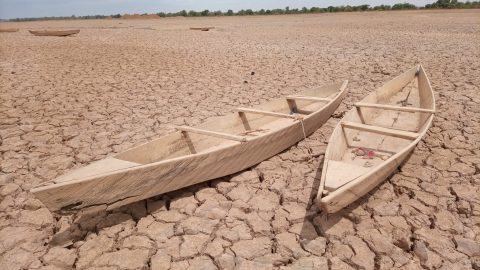In August 2021, the IPCC (Intergovernmental Panel on Climate Change) published the first report of the 6th season of reports on global climate change. This report forms the scientific basis in the field of physics for the subsequent reports.
The IPCC works within the framework of the United Nations to provide governments and decisionmakers with frequent assessments that illustrate the effects and future risks of, and options to adapt to future climate change.
234 authors from 34 countries contributed to the report. It refers to 14,000 scientific publications and 78,000 reviews/comments. 46 countries were able to comment on the finished version.
Climate change is manmade
One of the core statements of the report is the scientific fact that anthropogenic influence has warmed up the atmosphere, land, and oceans since 1750. This results in extensive changes in the atmosphere (the earth’s protective shell), the cryosphere (ice and snow), and the biosphere (all living beings). Also, each of the previous four decades was warmer than any other decade before that, from 1850 to today. The global rise in the average temperature since 1850-1900 and 2011-2019 has been about 1.1 degrees celsius (from here abbreviated with degree). Global warming amounted to +1 to +2 degrees celsius due to known greenhouse gases, whereas other human influences such as aerosols caused average temperatures to cool between 0 and 0.8 degrees. Natural (i.e. not human) causes were responsible for changes in the range between -0.1 and +0.1 degrees. The internal variability of the system also causes fluctuations between -0.2 and +0.2 degrees. Scientists have established with a high degree of certainty that greenhouse gases are responsible for the warming troposphere since 1979 and that the decrease in ozone in the stratosphere between 1979 and the mid-1990s caused the stratosphere to cool.
The simulation of the development of temperatures below juxtaposes natural causes (sun, volcanos) with human causes:
Heat waves and droughts are becoming more frequent and more intense
Heat waves, precipitation, and the resulting soil moisture have been established by the report as relevant physical risks. In all analysed scenarios (+1 or +1.5, +2, and +4 degrees), the land surface is affected more significantly by heat on a global scale than oceans, and the Arctic and Antarctica warm up faster than tropical regions. In higher altitudes as well as in the equatorial Pacific region and in monsoon regions, the amount of expected precipitation increases as well. However, in the subtropics and some tropics regions, precipitation will decrease. The degree of soil moisture follows the same pattern. We can also expect drastic changes with regard to the frequency of extreme weather events. Heatwaves, which in a world without human influence occur once every 50 years, were measured only once in 1850-1900. In the +1-degree scenario (which we are in at the moment), they have come up almost 5 times as often and at a 1.2 degrees higher intensity as well. In the +2-degree scenario, they occur 14 times as often. And finally, in a 4-degree scenario, these extreme events happen 40 times as often, with an intensity 5 degrees higher than between 1850 and 1900.
The situation is similar for heat waves and droughts that affect agriculture and ecological systems negatively. Between 1850 and 1900, they were observed only once. Now, they occur almost twice as often, and in a +4-scenario, they would happen four times as often.
Temperature rising in Europe more drastically than on (global) average
According to the results of the report, temperatures will rise above global average in Europe. Extreme-heat events will occur more frequently, and critical thresholds for ecosystems and anthropogenic systems will be crossed. The frequency of cold waves and days below zero will continue to decline. Whereas in the Northern hemisphere an increased amount of precipitation is to be expected for the winter months, in the Mediterranean region the opposite is going to be the case during summer. As a result, more frequent heat waves and droughts, i.e. dry conditions favouring large-scale fires, can be expected for the whole of Europe, but particularly for the Mediterranean regions. Floods will become more frequent in Europe, and the sea level will rise everywhere except in the Baltic region. As a result, coastlines will shift as well. Much like in past years, glaciers and permafrost will recede further, and the periods of snow cover in higher altitudes will become shorter.
Legal note:
Prognoses are no reliable indicator for future performance.
Legal disclaimer
This document is an advertisement. Unless indicated otherwise, source: Erste Asset Management GmbH. The language of communication of the sales offices is German and the languages of communication of the Management Company also include English.
The prospectus for UCITS funds (including any amendments) is prepared and published in accordance with the provisions of the InvFG 2011 as amended. Information for Investors pursuant to § 21 AIFMG is prepared for the alternative investment funds (AIF) administered by Erste Asset Management GmbH pursuant to the provisions of the AIFMG in conjunction with the InvFG 2011.
The currently valid versions of the prospectus, the Information for Investors pursuant to § 21 AIFMG, and the key information document can be found on the website www.erste-am.com under “Mandatory publications” and can be obtained free of charge by interested investors at the offices of the Management Company and at the offices of the depositary bank. The exact date of the most recent publication of the prospectus, the languages in which the fund prospectus or the Information for Investors pursuant to Art 21 AIFMG and the key information document are available, and any other locations where the documents can be obtained are indicated on the website www.erste-am.com. A summary of the investor rights is available in German and English on the website www.erste-am.com/investor-rights and can also be obtained from the Management Company.
The Management Company can decide to suspend the provisions it has taken for the sale of unit certificates in other countries in accordance with the regulatory requirements.
Note: You are about to purchase a product that may be difficult to understand. We recommend that you read the indicated fund documents before making an investment decision. In addition to the locations listed above, you can obtain these documents free of charge at the offices of the referring Sparkassen bank and the offices of Erste Bank der oesterreichischen Sparkassen AG. You can also access these documents electronically at www.erste-am.com.
Our analyses and conclusions are general in nature and do not take into account the individual characteristics of our investors in terms of earnings, taxation, experience and knowledge, investment objective, financial position, capacity for loss, and risk tolerance. Past performance is not a reliable indicator of the future performance of a fund.
Please note: Investments in securities entail risks in addition to the opportunities presented here. The value of units and their earnings can rise and fall. Changes in exchange rates can also have a positive or negative effect on the value of an investment. For this reason, you may receive less than your originally invested amount when you redeem your units. Persons who are interested in purchasing units in investment funds are advised to read the current fund prospectus(es) and the Information for Investors pursuant to § 21 AIFMG, especially the risk notices they contain, before making an investment decision. If the fund currency is different than the investor’s home currency, changes in the relevant exchange rate can positively or negatively influence the value of the investment and the amount of the costs associated with the fund in the home currency.
We are not permitted to directly or indirectly offer, sell, transfer, or deliver this financial product to natural or legal persons whose place of residence or domicile is located in a country where this is legally prohibited. In this case, we may not provide any product information, either.
Please consult the corresponding information in the fund prospectus and the Information for Investors pursuant to § 21 AIFMG for restrictions on the sale of the fund to American or Russian citizens.
It is expressly noted that this communication does not provide any investment recommendations, but only expresses our current market assessment. Thus, this communication is not a substitute for investment advice.
This document does not represent a sales activity of the Management Company and therefore may not be construed as an offer for the purchase or sale of financial or investment instruments.
Erste Asset Management GmbH is affiliated with the Erste Bank and austrian Sparkassen banks.
Please also read the “Information about us and our securities services” published by your bank.


